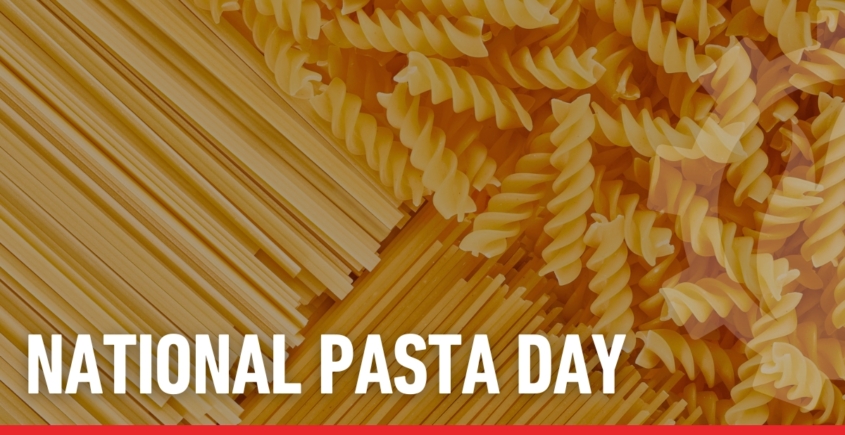Pasta For All!
As a devout “foodie” (which just means I pretty much love all food), today marks a special day on my calendar – National Pasta Day – simply celebrating the sheer joy of pasta. (whoever thought of this is a genius!) Though it’s widely observed on this day, the exact origin of this “holiday” is unclear (no formal proclamation exists…let’s start one!). We’ll have to wait some days for World Pasta Day (Oct 25th), globally recognized and supported by pasta manufacturers and food organizations around the world. I did some digging and found interesting tidbits about the day, pasta history, and fun facts. As I was composing this blog post, I tried to determine if I had a “favorite” pasta – is it traditional spaghetti smothered with Jackie’s sauce and meatballs and sausage, or is it my love of lasagna, those gooey golden layers of sauce, cheese, beef, and sausage! – or a kid’s favorite of simple macaroni and cheese. Orzo is fun, those pipe thingies are too (any shape), especially when the cheese and sauce sneak inside and hold the goodness. Speaking of inside, how about ravioli, with the different fillings – sausage, beef, chorizo, cheese, … ok, I’ll stop. Pasta la vista!

Listen to Dean while reading – golden!
Pasta originated in China as “noodles,” originally called “soup cake.” Archaeologists found the oldest noodle bowl in Lajia, China, dating back 4000 years. The earliest writing about pasta noodles dates back to the East Han Dynasty between 25 and 220 AD. The original pasta was made from rice and millet, a grain native to China. Durum wheat became the preferred ingredient for pasta in the Mediterranean.
Evidence of Etruscans making pasta dates back to 400 BC.. In the 1st-century writings of Horace, lagana (sg.: laganum) were fine sheets of fried dough and were an everyday foodstuff. Writing in the 2nd century, Athenaeus of Naucratis provides a recipe for lagana, which he attributes to the 1st-century Chrysippus of Tyana: sheets of dough made of wheat flour and the juice of crushed lettuce, then flavored with spices and deep-fried in oil. (YUM!) An early 5th-century cookbook describes a dish called lagana that consisted of layers of dough with meat stuffing, an ancestor of modern-day lasagna.
Pasta is documented as early as 1154 in Sicily, indicating centuries-long roots in Italian cuisine. The romantic story of Marco Polo introducing pasta to Italy from China is a myth – pasta was already well-known in Italy long before his travels. Most trace pasta’s origins even further back, suggesting Etruscan or ancient Mediterranean origins.
An astounding 600+ pasta shapes exist, each purposely designed to complement specific sauces or cooking methods. Wikipedia notes a slightly broader range – 310 shapes with over 1,300 documented names, many varying by Italian region (cavatelli alone can have up to 28 different names depending on locale).
The earliest pasta was similar to vermicelli—an Italian word that translates to “little worms” and the ancient Judaic text, the Talmud, makes one of the first references to boiling pasta.
Per capita, Italians consume approximately 51 pounds (23 kg) of pasta annually (about a pound a week – makes sense to me!), making them true connoisseurs. Average Americans consume about 20 pounds annually. Italy produces about 2.75 million tons of pasta each year, while the United States produces around 1.9 million tons.
Pasta comes in two main forms: Dried pasta: Made from durum wheat and water, great for storage and hearty dishes, and fresh pasta, which includes eggs and is more tender, ideal for delicate sauces and stuffed shapes like ravioli
SpaghettiOs were invented by Donald E. Goerke while he was working for Campbell Soup Company in the early 1960s. Tasked with creating a mess-free, spoon-friendly pasta for children, Goerke developed the small, round “O” shape that became a hit with both kids and parents. The product, first released in 1965 under Campbell’s Franco-American label, quickly became a popular canned food and a source of comfort for many.
Long, smooth pastas (spaghetti, angel hair) pair best with light, oil-based or tomato sauces. Ridged or tubular pastas (rigatoni, penne) hold chunky or thick sauces better. Tiny or shaped pastas are great in soups or pasta salads. Spaghetti comes from the word Spago, meaning string in Italian.
Some of my favorites:
Spaghetti: The iconic long, cylindrical pasta; comes in various thicknesses like spaghettini and spaghettoni. Perfect with tomato-based or meat sauces.
Fettuccine Alfredo: Rich, indulgent, and named after its creator. Consider comparing authentic Italian-style pasta with the American adaptation. And bring on the sauce!
When in the mood, go searching for recipes: Pesto from Genoa (Liguria), Bolognese from Bologna (Emilia-Romagna), Amatriciana, Carbonara (Central Italy), Pasta alla Norma, Pasta con le sarde (Sicily)
In 2021, German Andre Ortolf took the Guinness World Record for the most pasta (2.09 lbs) consumed in three minutes, and the largest bowl of pasta was created in Poland and weighed 7,900 kg. It took cooks 19 hours to prepare the pasta alla Bolognese.
Pasta has had some great movie moments, including depictions in The Apartment, The Sopranos, Elf, The Godfather, Eat Pray Love, and of course, Lady and the Tramp.
The most expensive restaurant pasta dish is $2,000 at a New York restaurant called Bice. It has two pounds of lobster, black truffles, and veal. The Portofino restaurant in Las Vegas serves Diamond and Gold lasagna made from white diamond truffles and edible gold leaf for a more “reasonable” $100 per serving.
For me, the best pasta is the one I’m looking at before eating. ENJOY!!
How did you do on last week’s logo contest?
Check out our logo guide for the “Nice Job, Chris” post here!






Leave a Reply
Want to join the discussion?Feel free to contribute!